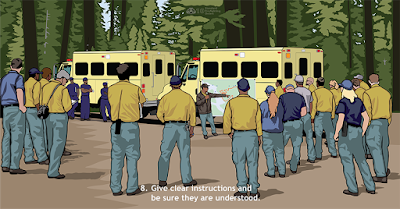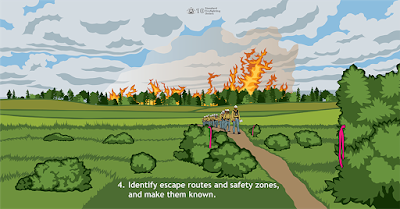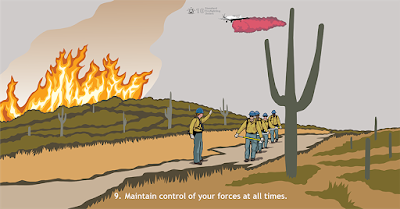“It is not only what we do, but also what we do not do, for which we are accountable." ~ Moliere (Jean-Baptiste Poquelin)1Much like watching funny videos on the internet, researching “leadership” can lead you down a rabbit hole that you may never find your way out of; at least, that is my hope for every person who aspires to be a great leader.
The subject today is about being an accountable leader. There are plenty of books, blogs, and videos on this subject, and I encourage you to read/watch ALL of them you come across. They say similar things, but in different ways; much like 5+4 equals 9, and so does 6+3; one isn’t less right than the other.
Accountability is defined by the Oxnard-Cambridge dictionary as a situation in which someone is responsible for things that happen and can give a satisfactory reason for them.2 Basically, it means that you don’t rely on the “Not Me” ghost from Family Circus comic strips.
Regardless of your current professional position, you are not exempt from occasionally failing to take responsibility for things that happen. The 10 Standard Fire Orders should serve as the foundation of what we’re accountable for at all leadership levels. Six of the orders are highlighted below.
The Oz Principle, by Roger Conners, Tom Smith, and Craig Hickman, discusses above and below the line thinking and accountability (this book should be required reading freshman year of high school). The book doesn’t excuse below the line thinking, but it also acknowledges that there are times when we all fall below. At some point, we have to rise above it and work on the four phases of above the line accountability.
I am a glass-half-full kind of person, as I assume most of you are reading this. Great leaders tend to see the bright side or lesson in every circumstance; that’s what gives them the ability to move on from setbacks and lead those who can’t see the forest for the trees. However, today we’re going to focus on the below the line behaviors to help identify when they creep into our organizations, incidents, and even our personal development.
“Below the line behaviors” described in the book are: “wait and see,” “confusion; someone else will tell me what to do,” “ignore it,” “it’s not my job,” “finger pointing,” and “covering your butt.” Each of these deserves a more in-depth discussion, but today I’m going to touch on each one briefly and encourage you to read the book and make notes of below the line behaviors you have observed and possibly even demonstrated.
 |
| (Credit: NWCG) |
Fire Order #6: Be alert. Keep calm. Think clearly. Act decisively.
Whether you’re an Incident Command type I or a firefighter type II, the buck stops and starts with you.
“Wait and see” is just a way of life for some. We have all experienced the stalling behavior where nothing gets decided. Maybe it’s overhead that acknowledges a problem but doesn’t understand how important it is to resolve, so they hold off on taking action on it. It’s not the same as ignoring it, which is covered in more detail in a bit.
Where else has this behavior manifested itself? Early in my fire career, I worked at an organization with three people in the fire program; a fire operations specialist and two firefighters. The other firefighter had been at the unit for three years and was still a firefighter type II and was very negative about not advancing his qualifications. When I asked him why he hadn't started any task books, he responded that the regional office hadn’t offered him the opportunity. My first thought was that I had made a mistake. I could have been like him and resigned myself to waiting on someone else to tell me when I was ready to advance my qualifications. Instead, I asked the FOS what I needed to do to get a task book initiated, and he told me who at the regional office I needed to speak. Within ten days, I had my task book in hand. Leadership isn’t just about leading others; it’s about taking control of your career and leading yourself too.
 |
| (Credit: NWCG) |
Fire Order #8: Give clear instructions and ensure they’re understood.
“Confusion; someone else will tell me what to do,” this may not be like most leaders. It can still rear its ugly head. Confusion happens, but it is a leader's responsibility to ask questions and ensure a clear understanding of intent. It’s a perfect example of why a leader's intent is an essential part of any mission, be it policy or operational. Leadership, especially in a dynamic field like fire management. The complexity of working with different personnel, training levels, and egos can be more like the children’s game “telephone.”
Word of caution with this behavior; while it’s a detriment to leaders and aspiring leaders, not everyone has the goals or desire to take on the responsibility to be leaders. If someone in your span of control regularly has to be told to step one, step two, step three, it does not mean they are below the line. They are just of a different mindset than you and me, which is okay. In the excellent essay by Russell Conwell, he says:
“…suppose I go into the high school tomorrow and ask, "Boys, who sunk the Merrimac?" If they answer me "Hobson," they tell me seven-eighths of a lie—seven- eighths of a lie, because there were eight men who sunk the Merrimac.”3Fire Order #9: Maintain control of your forces at all times.
Maintaining control and predicting every possible situation that arises is not the same thing. Maintaining control means being aware of what is happening and being cognitive of yourself and the people in your charge.
“Ignore it” has repeatedly happened at all leadership levels and frequently, sometimes at a significant cost of life and property. This behavior's root may lie in the unfamiliarity of a situation or being distracted by other priorities. We’ve all heard the adage one bad apple ruins a whole batch, yet as leaders, sometimes we find ourselves ignoring those bad apples instead or removing them from the team. By removing them, I do not mean cleaning the house of people who disagree with you! If you have someone in your span of control that is making waves, they may be doing it for a legitimate reason. Don’t discount someone’s poor attitude or performance as a reflection of them, but rather a potential area of improvement for your leadership. You may not only defuse a ticking time bomb but earn a valuable ally for the future.
Being a leader is challenging, and sometimes we have to be vulnerable to those we serve in our span of control.
 |
| (Credit: NWCG) |
Fire Order #5: Post lookouts when there is possible danger.
“It’s not my job,” as a leader, you have to not only be willing to wear different hats but able to function professionally in it. There are people in leadership positions that, unfortunately, are not leaders. The opening of Leading in the Wildland Fire Service (pg. 5) explains it best how this can happen:
“The authority to lead is established by law. Whether this authority is based on federal, state, or local law, we are legal agents exercising authority on behalf of our organizations.
The ability to lead is a different matter; it is something that cannot be legislated. To be effective, leaders must earn the trust and respect of others. A leader’s journey is a perpetual cycle of acquiring, shaping, and honing the knowledge and skills of leadership. The leadership journey is never finished.”4
“Pointing fingers,” for lack of better words and in the spirit of full disclosure on how I see it is merely cowardice. The Oz Principle has an excellent example of an executive who takes a promotion within an organization to a different division. This division had a culture other than the one he came from. Instead of listening and observing what was happening, he blamed the employees and his hire ups for setting him up for failure. At times it may seem like it may be someone else’s fault for a situation. However, pointing fingers and excusing your inaction or reaction is not effective leadership.
At one point in my career, I was informed that the status quo was below the minimum bar of expectations during my first performance appraisal. Yet I spent two more years frustrated, I was spinning my wheels, and I pointed fingers at the organization for my unhappiness. By doing this, I didn’t demonstrate a leader's skills and hindered my growth. Had I accepted that the organization's standards and mine didn’t line up, I could have saved a great deal of stress and achieved more. Change is hard, but it’s required occasionally for growth.
 |
| (Credit: NWCG) |
“Cover my butt” may be good advice while out in public or walking around your home with the windows open; it doesn’t belong in a leader's toolbox of tools. Accidents happen, mistakes will be made; and leaders need to have the intestinal fortitude to stand by the results even when it’s not favorable. There are standard operating procedures, standard operating guidelines, checklists, and numerous other protocols and tools for decision-making in the fire service. Still, none of it relieves us from our responsibility to your subordinates. That’s not a typo; leaders are responsible not only to their management above but the people they lead. When someone asks you why something didn’t go right, is your first reaction to deflect or justifying what happened to someone else? If so, the good news is you now can recognize it and start working on adjusting your response.
You have probably thought of a situation or two where maybe you lacked a little accountability. It’s OKAY! It doesn’t make you a bad leader, and it isn’t a scarlet letter you have to wear on your chest. Good leadership means you’re accountable for your actions but not infallible. I leave you with one last quote from one of the most valuable essay of the twentieth century, “As a Man Thinketh” by James Allen:
“…man only begins to be a man when he ceases to whine and revile, and commences to search for the hidden justice which regulates his life. And he adapts his mind to that regulating factor, he ceases to accuse others as the cause of his condition, and builds himself up in strong and noble thoughts; ceases to kick against circumstances, but begins to use them as aids to his more rapid progress, and as a means of the hidden powers and possibilities within himself.”5References
1Quote by Molière
2Enacademic.com
3Acres of Diamonds, Temple University.
4 Leading in the Wildland Fire Service
5As a Man Thinketh Quotes by James Allen, Goodreads.




A good read. We all have committed one of those like you said. It is important to know that you did, learn from it and not do it again. That is a lofty goal, one that isn't easily attainable *if attainable at all). A better goal is to identify it and do you best to head it off, or if you do "commit" one, try to correct it. Also help others not all into the same trap.
ReplyDelete